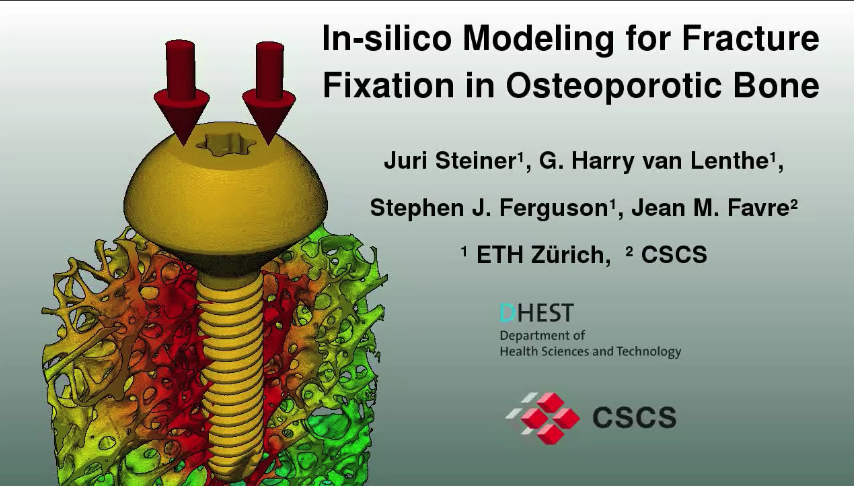Scientific Visualization: In-Silico Modeling for Fracture Fixation in Osteoporotic Bone
The scientific visualization In-Silico Modeling for Fracture Fixation in Osteoporotic Bone will be presented at the SC13 Scientific Visualization Showcase Exhibit in Denver. Authors of the visualization are Juri Steiner (ETH Zurich), G. Harry van Lenthe (KU Leuven), Stephen J. Ferguson (ETH Zurich) and Jean M. Favre (CSCS, Swiss National Supercomputing Center)
Osteoporosis has become more prevalent in our aging population, making fracture treatment more difficult because of an impaired peri-implant bone microstructural quality. Biomechanical tests are usually conducted to investigate the mechanical bone-screw competence. However, in vitro mechanical testing is expensive and time consuming because human bone material is sparse and shows a high variability. Alternatively, computational specimen-specific models make it possible to run different mechanical tests on the same specimen. A micro-CT based Finite Element (µFE) Analysis is used to investigate the mechanical competence of bone-screw models in silico. A cylindrical trabecular bone specimen is instrumented with a titanium screw and scanned using micro-computed tomography at a nominal isotropic resolution of 20 µm. µFE models were created for two cases: a two-component bone-screw model, and a three-component model including a soft interface layer (10 voxels thick). Youngs moduli for bone tissue, soft layer and titanium screw were 10 GPa, 2 GPa and 100 GPa, respectively. The models were solved using the parallel solver ParaSol, running with 384 parallel tasks for a model of 142 million hexahedral cells. Visualization was performed with a ParaView server with 64 tasks. The resulting force was 31% lower in model 2 compared to model 1. In model 2, high displacements occur only in the vicinity of the implant, better mimicking the deformation pattern of in vitro bone-screw constructs. Acknowledgements This work was funded by the Swiss Commission for Technology and Innovation (CTI 14067.1 PFLS-LS) and by Synthes, Solothurn, Switzerland.

